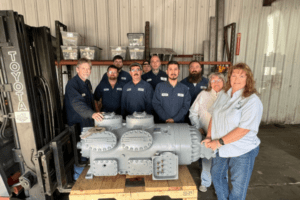 The compressor is the heart of the refrigeration system. The compressor acts as the pump that moves the refrigerant through the system. Temperature sensors start the compressor’s action. Refrigeration systems cool objects through repeated refrigeration cycles.
The compressor is the heart of the refrigeration system. The compressor acts as the pump that moves the refrigerant through the system. Temperature sensors start the compressor’s action. Refrigeration systems cool objects through repeated refrigeration cycles.
Before we proceed, here are some terms that you should know.
1. Compressor: The compressor is the pump that enables the flow of the refrigerant. The compressor works by increasing the pressure and temperature of the vaporized refrigerant. There are different types of compressors for refrigeration applications. Reciprocating, rotary, and centrifugal compressors are the most common among refrigeration units.
2. Condenser: The condenser is a set of coiled tubes. In the domestic refrigerator, you will find your compressor at the back of the appliance. The condenser cools the vaporized refrigerant turning it back to liquid.
3. Evaporator: The evaporator is the cooling component of the refrigeration system. It absorbs heat from the contents within the cooling appliance. In the domestic refrigerator, the evaporator is in your freezing compartment.
4. Expansion Valve: This device controls the flow of the liquid refrigerant. The expansion valve is thermostatic. It responds to the temperature that you set.
The Refrigeration Cycle
The refrigerant flows from the evaporator coil through the compressor. This flow raises the pressure of the coolant. The vaporized refrigerant then flows to the condenser where it transforms to liquid. As the refrigerant condenses to a liquid, it gives off heat. This explains why the condenser is relatively hot when you touch it.
From the condenser, the refrigerant flows to the expansion valve. There is a drop of pressure in the expansion valve. From the expansion valve, the refrigerant flows to the evaporator. The liquid refrigerant draws heat from the evaporator’ environment. This heat vaporizes the liquid refrigerant.
The vaporized refrigerant flows back to the compressor where the cycle continues.
How Different Compressors Work
1. The Reciprocating Compressor
This compressor employs back and forth piston motion to compress the vaporized refrigerant. Another name for the reciprocating compressor is the piston compressor. This compressor comprises a motor, a crankshaft, and some pistons.
The motor rotates the crankshaft, which then pushes the pistons.
Each crankshaft rotation achieves actions: suction, compression, and discharge. All these actions are in sequence. As a result, gas displacement is discontinuous and causes vibration.
Single-acting reciprocating compressors are those compressors where the refrigerant acts on one side. Double-acting compressors enjoy refrigerant action on two sides of the piston.
Types of single-acting compressors include;
- Open Type Compressors
- Serviceable Semi-Hermetic Compressors
- Bolted Serviceable Semi-Hermetic Compressors
- Welded Hermetic Compressors
These reciprocating compressors come in low, medium, and high operating temperature. You find reciprocating compressors in household refrigerators and freezers (welded hermetic compressors). In commercial refrigeration and air conditioning systems are semi-hermetic, and welded hermetic compressors.
2. The Rotary-Vane Compressor
The vane splits the cylinder into suction and discharges sections. The pistons rotate to increase and decrease the volumes of the sections. Continuous rotation achieves gas suction, compression, and discharge.
The operation of a rotary vane compressor includes five actions. These actions are; start, suction, compression, discharge then end. Each crankshaft rotation achieves all these five actions.
You can find rotary vane compressors in domestic refrigeration and air conditioning units. They also feature in heat pumps.
3. The Rotary-Screw Compressor
This compressor uses helical screw rotors to compress larger volumes of refrigerant. The compression involves the motor and the male and female rotors.
The motor rotates the male rotor through the crankshaft. The male rotor moves the female rotor as the rotors inter-mesh against each other.
The meshing rotors force the refrigerant through the suction port of the compressor. The compressed refrigerant leaves via the discharge port at a higher pressure.
The screw compressor competes with large reciprocation and small centrifugal compressors. You find rotary screw compressors in commercial and industrial refrigeration and air-conditioning systems.
4. The Centrifugal Compressor
Another name for the centrifugal compressor is the turbo or radial compressor. This machine compresses the refrigerant by kinetic energy though rotating impellers. As the impellers rotate, they force the refrigerant through the inlet vane. The higher the impeller speed, the higher the pressure.
The high-pressure refrigerant then passes through the diffuser. In the diffuser, the gas volume of the refrigerant expands as the speed decreases. Centrifugal compressors convert the kinetic energy of high-speed, low-pressure refrigerant. The result is low-speed high-pressure gas.
Centrifugal compressors are suitable for large cooling applications. The centrifugal compressor is a favorite among commercial and industrial refrigeration systems.
The mode of action of different compressors makes them suitable for some applications. The design could also make a compressor unsuitable for other uses. Attributes like cooling capability, price, efficiency, and reliability are key factors to consider.
The compressor is central to refrigeration, and you should know and understand how it works. At Compressors Unlimited, we have a huge supply of remanufactured compressors for your commercial refrigeration needs.












